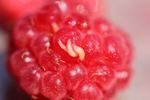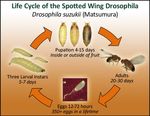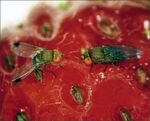Spotted-wing Drosophila: Management in Home Plantings
←
→
Page content transcription
If your browser does not render page correctly, please read the page content below
Spotted-wing Drosophila:
Management in Home Plantings
Fact Sheet No. 5.596 Insect Series|Home & Garden
Whitney Cranshaw1
it develops within ripening fruit rather than
Spotted-wing drosophila (SWD)2 is an on yeasts. Quick Facts
insect only recently found in Colorado that Adults of the spotted-wing drosophila
has proven to be very damaging to several are tiny flies (ca 1/0-inch length, 1/5-inch • Spotted-wing drosophila
kinds of fruit crops. Small fruits, notably wingspan), light brown and in general ap- is a small fly that develops
late bearing raspberries and strawberries, pearance, fairly typical of most other small within many kinds of fruits.
are at particular risk of damage. Damage fruit flies. The males are distinguishable It is particularly damaging
is caused by the developing larvae, which from other species of Drosophila by having to late fruiting plantings of
feed within fruit causing it to rapidly soften a dark spot towards the tip of the wing, a raspberries, blackberries, and
(Figure 1). “spotted wing” (Figure 2). Females are less strawberries.
Spotted-wing drosophila is native to easily distinguished, requiring some mag-
Japan and was first observed in North nification. They possess a structure used to • The young stages are tiny
America (California) in 2008. It then spread lay eggs (ovipositor) that is relatively large maggots that feed within
rapidly throughout much of the United and uniquely serrated, which allows them berries and cause them to
States and Canada. First detected in Colo- rapidly soften.
rado (Fort Collins) in 2012, it has since been
found to occur in numerous sites in both • Regular picking of all ripe
eastern and western Colorado. fruit at least twice a week is
useful in reducing damage by
spotted-wing drosophila.
• Insecticides are available to
help control spotted-wing
drosophila but they can only
be applied during times of the
day when pollinating insects
Figure 2: Adults of a “vinegar fly” or “small fruit
fly” on an overripe peach. These can be common are not actively visiting the
insects in homes or areas where fermenting crop.
materials are present, but do not attack intact fruit
as does the spotted-wing drosophila.
Figure 1: Larvae of spotted-wing drosophila in a
raspberry.
Life History and Habits
Spotted-wing drosophila (Drosophila
suzukii)2 is a member of the “small fruit fly”
or “vinegar fly” genus Drosophila. The small
fruit flies are familiar insects to many peo-
ple, sometimes found abundantly indoors,
where they feed on yeasts associated with
overripe fruit or the sediment of beverage
containers. An important difference in the
habit of the spotted-wing drosophila is that ©Colorado State University
Extension. 3/17.
1
Whitney Cranshaw is a Professor and Extension Figure 3: Comparison of a female (left) and male extension.colostate.edu
Specialist of entomology at Colorado State University (right) spotted-wing drosophila. Photograph
3/2017 by Eric LaGrasa, courtesy of the Washington
Department of Agriculture.
2
Drosphila suzukii Diptera: Drosophilidaeto insert eggs into thin-skinned fruits sheltered location. In 4-15 days, adults
(Figure 3). emerge from the pupae to mate and lay
Winter is spent in the adult stage with eggs continuing the cycle (Figure 6).
the flies remaining in a semi-dormant Optimal conditions for development
condition (diapause) during the cold are around 680-770F (200-250C) and sev-
months. During this time they may use eral generations are produced annually.
many different sites for winter protection, Populations typically start to increase
but areas within the skins and husks of rapidly in early July. The highest numbers
decaying fruit can be particularly impor- of insects are usually present in August
tant places where they will survive winter. and September.
With the return of warm weather in spring Spotted-wing drosophila can breed
the adults will emerge and seek out hon- and develop within a wide variety of
eydew, nectar and oozing sap to sustain Figure 6: Adult male (left) and female (right) ripening thin-skinned fruits, including
spotted-wing drosophila. Photograph courtesy of
themselves. Beverly Gerdeman, Washington State University. various berries, tree fruits, and fleshy fruits
As ripening fruits become available in produced by various trees and shrubs
late spring and early summer, egg laying (Table 1). They can also develop in ad-
resumes. When laying eggs, the female Table 1. The relative importance of ditional fruits, such as apples and crabap-
creates a small slit in fruit skin and inserts various fruits for spotted-wing dro- ples, after they have become overripe.
1 to 3 eggs. This is repeated over a period sophila (SWD), based on Colorado
surveys.
of weeks and a single female can lay up to
350 eggs in her lifetime (Figure 4). Most Highly Favored Host Plants Management of Spotted-
Raspberry
Strawberry wing Drosophila
Blackberry
Moderately Important SWD Host Plants Trapping/Monitoring
Chokeberry This insect can easily be captured in
Elderberry
Sweet cherry traps baited with apple cider vinegar and
Nanking cherry other attractants. A typical trap design
Tart cherry uses a red plastic cup with a clear plastic
Plums
Redtwig dogwood lid to keep out water (Figure 7). The flies
Currant (particularly Red Lake) enter the trap through a series of holes
Gooseberry (3/16” to ¼” diameter) punched along the
Apples, Crabapples (after fallen on the ground
and thoroughly softened sides near the top of the cup. The trap
is hung from the plants using a string or
Figure 4: Eggs of spotted-wing drosophila laid on Other Fruiting Plants that Support SWD twist tie that threads through two of the
a strawberry fruit. Photograph courtesy of Hannah Regent serviceberry
Burrack, North Carolina State University. European cotoneaster holes.
Scarlet Hawthorn, Arnold Hawthorn
Yew
Depending on temperature, the eggs Grapes (after fully ripening)
Tatarian honeysuckle
can hatch in 12-72 hours. The larvae, tiny Viburnum 'Emerald Triumph'
maggots pale in color, will then feed in- Blueberry
side the fruit (Figure 5). They become full
Fruiting Plants Grown in Colorado that
grown in approximately 5 to 7 days after Have Not Been Observed as SWD Hosts )
which they transform into pupae. Larvae Asparagus*
may either remain inside the fruit to pu- Barberry
Cactus
pate or crawl away to pupate in another Cotoneaster (except European)
Bittersweet
Chokecherry*
Euonymus 'Recap European'
Hawthorn (except Arnold, Scarlet) Figure 7: Life cycle of the spotted-wing drosophila.
Junipers Figure courtesy of Cornell University/NYS IPM
Mock strawberry Program.
Mountain-ash
Cheyenne privet (Ligustrum)
Rose* A small amount (one or two ounces)
Russian olive
Skunkbush of attractant is then put in the bottom of
Sugar hackberry the cup. Apple cider vinegar is probably
Snowberry the most commonly used attractant and
Viburnum (except Emerald Triumph)
Virginia creeper is quite easy to use. But there are many
other effective lures, typically involving
Figure 5: Larvae of spotted-wing drosophila in a * These plants have been reported elsewhere
strawberry fruit. Photograph courtesy of Hannah red wine or various fermenting materials,
as being capable of supporting development
Burrack, North Carolina State University. of spotted-wing drosophila alone or in combination. Adding a drop
or two of detergent can improve capture.The trap should then be placed in a the fruit. Refrigerated to 350F (20C) will
shaded area, hung within the crop near prevent any further development of in-
the fruit. Traps should then be checked sects and kill those that are present within
on a regular basis, at least once a week. about 3 days.
When checking a sample dump the Any damaged fruit that is not har-
contents into a shallow light colored tray. vested for consumption should also be
To then identify spotted-wing drosophila removed and destroyed. Placing culled
one must closely examine all the fruit flies fruit in a plastic bag and allowing it to
in the sample. A bit of magnification is heat in the sun can reliably kill develop-
very useful for this, as it is necessary to ing insects. Putting infested fruit in a
observe the small spot on the wing of compost pile is not a reliable way to kill
the males to determine if SWD is pres- developing SWD.
ent. (These traps will collect other species
of small fruit flies but they will not have Sanitation
a spot on the wing. Female SWD also Many kinds of trees and shrubs pro-
lack the spot on the wing.) Record the duce fruits that can support the develop-
number of male spotted-wing drosophila ment of spotted-wing drosophila (Table
each time the traps are examined. Add 1). Some of these can be particularly
fresh bait and rehang the trap after each important for this insect and it is useful to
sampling. remove these alternate foods. Dropped
Monitoring spotted-wing drosophila apples and crabapples that soften on
with these traps is useful for three rea- the ground should be cleared out. Fallen
sons. For one, it can let one know if the peaches and plums are also important
insect is present at the site, as many areas food sources that are relatively easy to
have not yet become infested. Where remove.
the insect is known to be present, traps
can indicate when the adult flies begin Crop Canopy Management
to move into susceptible crops. And, if
Spotted-wing drosophila prefers
traps are regularly checked and captures
dense shade and cooler areas in the
recorded, it is possible to detect if there
canopy. Pruning crops in ways that open
are increases – or decreases – in the
up the crop canopy can deter insects from
numbers of insects present. This is useful
colonizing the crop.
information when deciding what type of
management might be needed.
Cultivar selection
Although these traps are very effective
in capturing spotted-wing drosophila, The crops most badly damaged by
they only capture a fraction of the flies SWD are late season cultivars of raspber-
that are attracted to the traps, perhaps a ries, blackberries and strawberries. Shift-
ing to cultivars that bear early in the year Figure 8 a, b: Two trap designs for spotted-wing
third. Furthermore, SWD is a fairly mobile drosophila. One (a) is a red plastic cup with a
insect and new flies can be expected to (“June bearers”) can largely avoid damage clear top with entry holes punched near the top.
continuously move into plantings. As a since SWD populations are low when The second (b) uses a clear container but has red
crops ripen. tape to attract the insects and has holes in the top.
result, when used alone, trapping has not Both designs can use lures such as vinegar, red
proved an effective method to control wine, or similar fermenting material. Photographs
this insect. Crop coverings courtesy of (a) Bob Hammon and (b) Deryn
Davidson, Colorado State University.
Nets of fine mesh (1 mm) can be used
to exclude flies from plants. Such cover-
Cultural and Mechanical ings need to be in place before ripening
Controls fruit is present that will attract adult SWD. Chemical Control
The netting should also be draped in a Insecticides applied to kill the adult
Frequent harvest intervals way to prevent direct contact with the flies can be effective for control of spot-
As fruit ripens it should be regularly fruit to avoid eggs being laid through the ted-wing drosophila. However, in home
and thoroughly picked. If done every 3 or mesh. gardens options of available products are
4 days, this can prevent insects from suc- The use of these coverings will also quite limited (Table 2). Also, some SWD
cessfully developing in the crop, reducing exclude other insects, including pollina- susceptible crops flower and produce fruit
their numbers. tors. This can be an important consider- over an extended period, such as raspber-
Harvested fruit should either be imme- ation when the crop is not self-fertile and ries. In these situations special care must
diately consumed or stored in a refrigera- benefits from cross pollination. be taken to prevent killing bees and other
tor. If left unrefrigerated any insects pres- pollinators visiting the crop.
ent will continue to develop and damageProducts containing the active ingredi- Table 2. A summary of insecticides
ent spinosad (spinosyns) can provide con- useful for control of spotted-wing dro-
trol for about 5 to 7 days. Less commonly sophila on raspberries, blackberries
available is the insecticide acetamiprid, and strawberries in home gardens
which is similarly effective. Insecticides Active Ingredient: Spinosad/Spinosyns
that have very short residual activity, such Trade Names: Bonide Captain Jack’s Dead
Bug Brew, Natural Guard Spinosad Land-
as pyrethrins or insecticidal soaps, have scape & Garden Insecticide, ferti-lome Borer,
not proven to be effective for control of Bagworm, Leafminer & Tent Caterpillar Spray,
spotted-wing drosophila. others
Preharvest Interval (caneberries, strawber-
Thorough spray coverage is important ries): 1 day
for effective control. Particular attention Minimum Interval Between Treatments: 5
should be given to cover the underside days
Pollinator Protection Statement: “This
of leaves and the interior of plantings product is toxic to bees exposed to treatment
where SWD flies spend the most time. for 3 hours following treatment. Do not apply
Adding a small amount of sugar to the this pesticide to blooming, pollen-shedding or
nectar-producing parts of plants if bees may
spray solution (2 tsp/gal) has been shown forage on the plants during this time period.”
to improve control when using spinosad
or acetamiprid. The adult flies feed on Active Ingredient: Acetamiprid
Trade Names: Ortho Flower, Fruit and Veg-
sugars and by adding sugar to the spray etable Insect Killer
solution it increases its effectiveness by Preharvest Interval (caneberries, strawber-
producing a bait in addition to a cover ries): 1 day
Minimum Interval Between Treatments: 7
spray. days
If plants continue flowering when sus- Pollinator Protection Statement: “This
ceptible ripening fruit is present potential product is toxic to bees exposed to direct
treatment. Do not apply this product while
conflicts with pollinating insects can oc- bees are actively visiting the treated area.”
cur. When this happens there are specific
label instructions that must be followed
to avoid killing these desirable species.
No pesticides, of any type, may be applied
to a flowering crop during periods of the
day when bees are actively present and
foraging in the crop. The insecticides list-
ed in Table 2 can be safely applied if they
are used during times of the day when
bees are no longer on the crop, such as
dusk or dawn. These periods of time may
also be most appropriate for control since
the adult flies are most active in the crop
during these times.
Colorado State University, U.S. Department of
Agriculture and Colorado counties cooperating.
CSU Extension programs are available to all without
discrimination. No endorsement of products mentioned
is intended nor is criticism implied of products not
mentioned.You can also read

























































